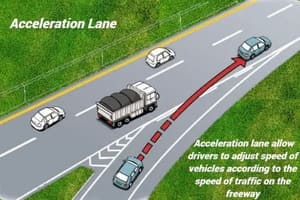Acceleration Lane – What is an Acceleration Lane?
An acceleration lane is a speed change lane before merging onto the freeway. This lane enables drivers to change their vehicle’s speed in accordance with the flow of freeway traffic. As motorists driving onto an acceleration lane, drivers must get up to the speed limit to the flow of traffic on the freeway. However, drivers also must yield the right of way to the traffic already present on the freeway.
What is an Acceleration Lane?
The acceleration lane is where you usually can accelerate the speed of your vehicle to safely merge onto freeway traffic. It is a connecting road between the freeway and other linking roads. The purpose of acceleration lane is to allow drivers to accelerate their vehicles to the same pace as on the freeway traffic. It provides a transition area for vehicles joining the roadway, helping to maintain a smooth and safe traffic flow.
Key Features and Functions
Length and Design:
An acceleration lane is an extended portion of the on ramp, providing enough distance for vehicles to accelerate to a safe merging speed. The length of the acceleration lane can vary depending upon traffic volume and road design.
Purpose:
It allows drivers entering the roadway to match the speed of vehicles already traveling in the adjacent lanes, minimizing disruptions and potential hazards.

Acceleration Lane Length:
The length of the acceleration lane provides drivers with sufficient space to gradually increase their speed and merge smoothly. It is essential for drivers entering the roadway to utilize the acceleration lane effectively and reach a speed that aligns with the prevailing traffic conditions.
Yielding and Merging:
When entering main roadway the drivers must yield to the traffic already in the main road. It is also important for drivers on the main roadway to be aware of merging vehicles and make adjustments to accommodate their entry.
Signage and Markings:
Acceleration lanes are typically marked with signs indicating their purpose and often have merge signs or arrows to guide drivers entering the main lanes. Clear signage and road markings help drivers understand the merging process and promote safe and efficient traffic flow.
Driver Responsibility:
Drivers entering the main roadway from an acceleration lane should use their turn signals to indicate their intention to merge smoothly. Drivers already on the main roadway should be aware of merging vehicles and make accommodations to allow for a seamless merge.
In summary, the acceleration lane on freeway is used for transitional space, allowing vehicles entering from an on-ramp to accelerate and merge safely with the flow of traffic on the main roadway. Proper utilization of acceleration lanes and adherence to merging procedures contribute to overall road safety and help maintain efficient traffic movement.
Can you stop in the Acceleration Lane?
When entering the freeway, never stop in the entrance lane to avoid rear end collision. If there is not enough room to safely enter the freeway because of excessively heavy traffic then you can stop in the entrance lane. Stopping on an acceleration lane can cause several issues and potentially lead to dangerous situations. Here are some potential consequences:
- The acceleration is where you usually can increase your speed to merge smoothly into the freeway traffic. But stopping on an acceleration lane can cause disruption in the flow of traffic.
- The acceleration lane on freeway is used for speed up the vehicles. If you stop in this lane, the vehicles behind you may not expect it and it can cause rear end collision.
- Stopping in this speed change lane can also reduce visibility of other drivers and make difficult for them to merge safely onto the main roadway.
- Stopping in a speed change lane can reduce the available space for merging vehicles to accelerate and enter the main traffic flow smoothly.
- If multiple vehicles stop on the speed change lane, it can quickly lead to congestion, especially during peak traffic hours. This congestion can extend onto the main road and can cause delays and further disruptions.
Improve Your Road Signs Knowledge, Take a Free Road Signs Knowledge Test.
Frequently Asked Questions in DMV Written Tests
The acceleration lane on freeways is used for ________.
The acceleration lane on freeway is used for speed up the vehicle.
Once in the acceleration lane you should: mark all that are correct
Once in the acceleration lane you should, increase the speed of your vehicle and look for gaps to safely merge into traffic.
As you enter the de-acceleration lane or the exit ramp, slow down and_____________.
As you enter the de-acceleration lane or the exit ramp, slow down and maintain a safe cushion of space ahead and behind your vehicle.
This question appeared in the following DMV Tests.
Find Out More
How to drive in a weave zone sign area?
Flagger Ahead Sign: What does it mean?
Who has the right of way at a 4 way stop sign?
Divided highway ends sign – What does it mean?

